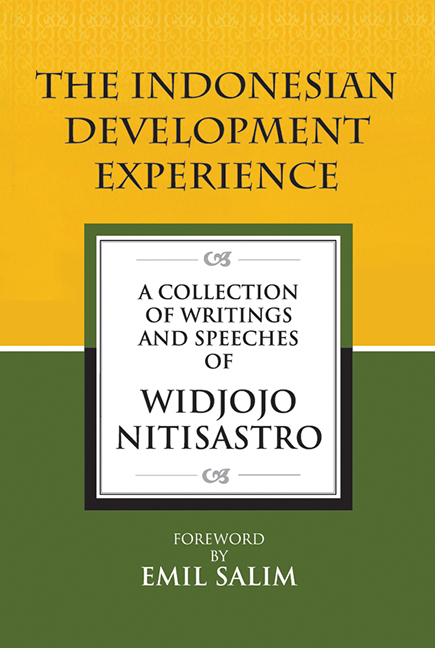Book contents
- Frontmatter
- Dedication
- Frontispiece
- Contents
- Foreword
- Introduction
- Part I PLANNING OF INDONESIA'S DEVELOPMENT
- Part II IMPLEMENTATION OF INDONESIA'S DEVELOPMENT
- Part III FACING VARIOUS ECONOMIC CRISES
- 14 The International Monetary Crisis (1971)
- 15 Food Crisis (1972)
- 16 PERTAMINA Crisis (1975)
- 17 Devaluation of the Rupiah (1978)
- 18 Fuel Price Increase (1982)
- 19 World's Oil-based Fuel Prices Dived (1986)
- Part IV SETTLEMENT OF FOREIGN DEBT
- Part V EQUITABLE DEVELOPMENT
- Part VI INDONESIA AND THE WORLD
- Index
- About the Author
15 - Food Crisis (1972)
from Part III - FACING VARIOUS ECONOMIC CRISES
Published online by Cambridge University Press: 21 October 2015
- Frontmatter
- Dedication
- Frontispiece
- Contents
- Foreword
- Introduction
- Part I PLANNING OF INDONESIA'S DEVELOPMENT
- Part II IMPLEMENTATION OF INDONESIA'S DEVELOPMENT
- Part III FACING VARIOUS ECONOMIC CRISES
- 14 The International Monetary Crisis (1971)
- 15 Food Crisis (1972)
- 16 PERTAMINA Crisis (1975)
- 17 Devaluation of the Rupiah (1978)
- 18 Fuel Price Increase (1982)
- 19 World's Oil-based Fuel Prices Dived (1986)
- Part IV SETTLEMENT OF FOREIGN DEBT
- Part V EQUITABLE DEVELOPMENT
- Part VI INDONESIA AND THE WORLD
- Index
- About the Author
Summary
Introductory Note: A food crisis occurred in 1972. It was known as the “rice crisis” in Indonesia, a country where most of the population considers rice as the staple food. Rice prices jumped uncontrollably. Rice production had declined far below that of earlier years. It had been the policy of the government in previous years to handle price increases by selling its rice buffer stock to the public. At that time (1972), however, the rice stock was so limited that it could not cushion the impact of the soaring prices for rice in the markets. The problem was that there had been reports from senior agricultural and regional officials that the rice production was quite high; contrary to reports from the Central Statistics Agency, which said that the production was actually lower than in previous years. Because there were such great contrasts among the various reports, it was stressed, time and again, that the benchmark was to be the rice price level at any given harvest time. If the rice price at harvest time was higher than that of the year before, this would be considered an indication of lower production rates. So, what we used as a guideline was the rice price at harvest time and not the confusing paddy production forecast reports.
However, apparently certain senior officials at the agriculture ministry and in regional administrations were reluctant to report that the rice production in their areas was lower than in the years before. There was also another problem that worsened the government's buffer situation. That was the requirement for farmers to sell the higher quality rice or unhusked rice to the government, so it could be preserved longer. This caused the government's rice and unhusked procurement from the farmers to drop. To deal with the declining production, the government took various actions, all of which required time to implement. The impact of this time gap was exacerbated by continued confusion in the production reports and the stringent requirement on rice quality. After undertaking some fruitful policies, including importing rice on a large scale, the government then decided to convey a comprehensive explanation of the problem to the House of Representatives and the public. Eventually, the prices could be brought under control. The government's explanation was conveyed by the National Planning Agency (Bappenas) on 14 December 1972.
- Type
- Chapter
- Information
- The Indonesian Development ExperienceA Collection of Writings and Speeches, pp. 164 - 178Publisher: ISEAS–Yusof Ishak InstitutePrint publication year: 2011



